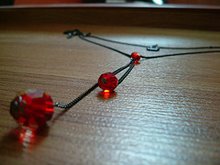









Amber is the common name for fossil resin that is appreciated for its inherent beauty and is widely used for the manufacture of ornamental objects. Although not mineralized, it is sometimes considered and used as a gemstone. Most of the world's amber is in the range of 30–90 million years old. Semi-fossilized resin or sub-fossil amber is called copal.
Amber is heterogeneous in composition, but consists of several resinous bodies more or less soluble in alcohol, ether and chloroform, associated with an insoluble bituminous substance. Amber is a macromolecule by free radical polymerization of several precursors in the labdane family, communic acid, cummunol and biformene.[1] Labdanes are tetrameric terpenes (C20H32) and trienes which means that the organic skeleton has three alkene groups available for polymerization. As amber matures over the years, more polymerization will take place as well as isomerization reactions, crosslinking and cyclization. The average composition of amber leads to the general formula C10H16O.
Heating amber will soften it and eventually it will burn, which is why the German word for amber is bernstein. Heated rather below 200°C, amber suffers decomposition, yielding an "oil of amber", and leaving a black residue which is known as "amber colophony", or "amber pitch"; when dissolved in oil of turpentine or in linseed oil this forms "amber varnish" or "amber lac".
True amber yields on dry distillation succinic acid, the proportion varying from about 3 to 8%, and being greatest in the pale opaque or bony varieties. The aromatic and irritating fumes emitted by burning amber are mainly due to this acid. True Baltic amber is distinguished by its yield of succinic acid, for many of the other fossil resins which are often termed amber contain either none of it, or only a very small proportion; hence the name succinite proposed by Professor James Dwight Dana, and now commonly used in scientific writings as a specific term for the real Prussian amber. Succinite has a hardness between 2 and 3, which is rather greater than that of many other fossil resins. Its specific gravity varies from 1.05 to 1.10. An effective tool for Amber analysis is IR spectroscopy. It enables the distinction between baltic amber and non-Baltic varieties because of a specific carbonyl absorption and it can also detect the relative age of an amber sample.
Often amber (particularly with insect inclusions) is counterfeited using a plastic resin similar in appearance. A simple test (perfomed on the back of the object) consists of touching the object with a heated pin and determining if the resultant odor is of wood resin. If not, the object is counterfeit, although a positive test may not be conclusive owing to a thin coat of real resin. Often counterfeits will have a too perfect pose and position of the trapped insect.
Ref.Wikipedia




No comments:
Post a Comment